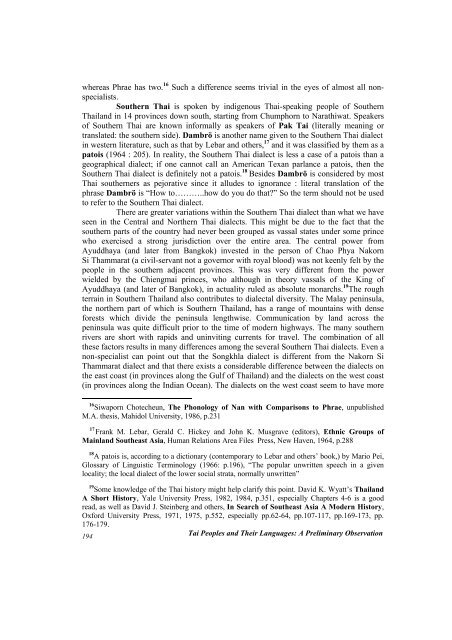Tai Peoples and Theirs Languages: A Preliminary ... - Khamkoo
Tai Peoples and Theirs Languages: A Preliminary ... - Khamkoo
Tai Peoples and Theirs Languages: A Preliminary ... - Khamkoo
Create successful ePaper yourself
Turn your PDF publications into a flip-book with our unique Google optimized e-Paper software.
whereas Phrae has two. 16 Such a difference seems trivial in the eyes of almost all nonspecialists.<br />
Southern Thai is spoken by indigenous Thai-speaking people of Southern<br />
Thail<strong>and</strong> in 14 provinces down south, starting from Chumphorn to Narathiwat. Speakers<br />
of Southern Thai are known informally as speakers of Pak <strong>Tai</strong> (literally meaning or<br />
translated: the southern side). Dambrö is another name given to the Southern Thai dialect<br />
in western literature, such as that by Lebar <strong>and</strong> others, 17 <strong>and</strong> it was classified by them as a<br />
patois (1964 : 205). In reality, the Southern Thai dialect is less a case of a patois than a<br />
geographical dialect; if one cannot call an American Texan parlance a patois, then the<br />
Southern Thai dialect is definitely not a patois. 18 Besides Dambrö is considered by most<br />
Thai southerners as pejorative since it alludes to ignorance : literal translation of the<br />
phrase Dambrö is “How to………..how do you do that?” So the term should not be used<br />
to refer to the Southern Thai dialect.<br />
There are greater variations within the Southern Thai dialect than what we have<br />
seen in the Central <strong>and</strong> Northern Thai dialects. This might be due to the fact that the<br />
southern parts of the country had never been grouped as vassal states under some prince<br />
who exercised a strong jurisdiction over the entire area. The central power from<br />
Ayuddhaya (<strong>and</strong> later from Bangkok) invested in the person of Chao Phya Nakorn<br />
Si Thammarat (a civil-servant not a governor with royal blood) was not keenly felt by the<br />
people in the southern adjacent provinces. This was very different from the power<br />
wielded by the Chiengmai princes, who although in theory vassals of the King of<br />
Ayuddhaya (<strong>and</strong> later of Bangkok), in actuality ruled as absolute monarchs. 19 The rough<br />
terrain in Southern Thail<strong>and</strong> also contributes to dialectal diversity. The Malay peninsula,<br />
the northern part of which is Southern Thail<strong>and</strong>, has a range of mountains with dense<br />
forests which divide the peninsula lengthwise. Communication by l<strong>and</strong> across the<br />
peninsula was quite difficult prior to the time of modern highways. The many southern<br />
rivers are short with rapids <strong>and</strong> uninviting currents for travel. The combination of all<br />
these factors results in many differences among the several Southern Thai dialects. Even a<br />
non-specialist can point out that the Songkhla dialect is different from the Nakorn Si<br />
Thammarat dialect <strong>and</strong> that there exists a considerable difference between the dialects on<br />
the east coast (in provinces along the Gulf of Thail<strong>and</strong>) <strong>and</strong> the dialects on the west coast<br />
(in provinces along the Indian Ocean). The dialects on the west coast seem to have more<br />
16 Siwaporn Chotecheun, The Phonology of Nan with Comparisons to Phrae, unpublished<br />
M.A. thesis, Mahidol University, 1986, p.231<br />
17 Frank M. Lebar, Gerald C. Hickey <strong>and</strong> John K. Musgrave (editors), Ethnic Groups of<br />
Mainl<strong>and</strong> Southeast Asia, Human Relations Area Files Press, New Haven, 1964, p.288<br />
18 A patois is, according to a dictionary (contemporary to Lebar <strong>and</strong> others’ book,) by Mario Pei,<br />
Glossary of Linguistic Terminology (1966: p.196), “The popular unwritten speech in a given<br />
locality; the local dialect of the lower social strata, normally unwritten”<br />
19 Some knowledge of the Thai history might help clarify this point. David K. Wyatt’s Thail<strong>and</strong><br />
A Short History, Yale University Press, 1982, 1984, p.351, especially Chapters 4-6 is a good<br />
read, as well as David J. Steinberg <strong>and</strong> others, In Search of Southeast Asia A Modern History,<br />
Oxford University Press, 1971, 1975, p.552, especially pp.62-64, pp.107-117, pp.169-173, pp.<br />
176-179.<br />
<strong>Tai</strong> <strong>Peoples</strong> <strong>and</strong> Their <strong>Languages</strong>: A <strong>Preliminary</strong> Observation<br />
194
















